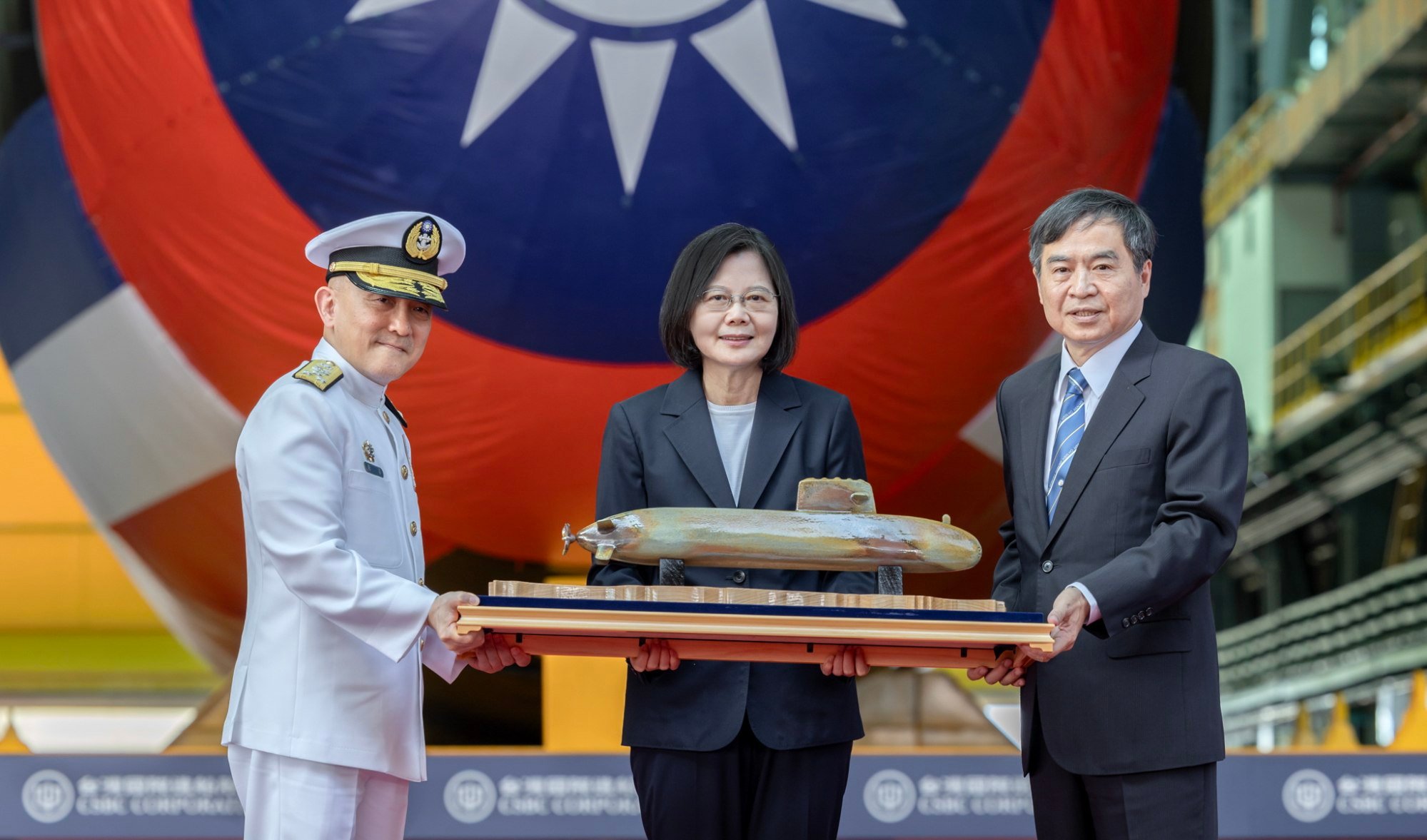Taiwan has unveiled its first home-built submarine, which is expected to play a leading role in asymmetric warfare in the event of conflict with mainland China.
However, local defence analysts warned that it will take time for it to become combat ready and building up the Taiwanese navy’s submarine fleet in the face of a growing threat from the People’s Liberation Army will take time.
The prototype vessel – set to be completed by the end of next year – was officially named Hai Kun, or Narwhal, by Taiwanese President Tsai Ing-wen during a ceremony in the southern city of Kaohsiung on Thursday.
Do you have questions about the biggest topics and trends from around the world? Get the answers with SCMP Knowledge, our new platform of curated content with explainers, FAQs, analyses and infographics brought to you by our award-winning team.
“History will forever remember this day,” said Tsai as she stood in front of the prototype sealed under the cover of a huge Taiwanese flag.
Tsai, who ordered the building of the ship shortly after she became the island’s leader in 2016, said the island was able to produce its first submarine despite all odds after seven long years.
“In the past, a domestically developed submarine was considered an impossible task, but today, a submarine designed and built on our own is right before us. We did it,” she said, adding it was not only a new milestone for the island but also an “important realisation of our concrete commitment to defending” Taiwan.
Tsai said it was an important development towards developing the island’s asymmetric warfare capacity.
Taiwanese President Tsai Ing-wen’s popularity hit by #MeToo and egg scandals
“We will continue to complete equipment installation, testing, and sea trial of the prototype so that by 2025 ... we will have three submarines with full combat capabilities,” she said.
The Taiwanese navy already has two submarines that were built in the Netherlands in 1986.
Beijing, which views Taiwan as part of its territory and has never renounced the use of force to bring it under its control, has steadily ramped up its military pressure since Tsai refused to accept the one-China principle after her election in 2016.
It has intensified its military operation around Taiwan since then US House speaker Nancy Pelosi visited Taipei last August in a trip seen by Beijing as a serious violation of its sovereignty and a breach of Washington’s one-China policy.
The United States – which like other countries does not recognise Taiwan as an independent state but is opposed to unilateral changes in the status quo – has been pushing the self-ruled island to strengthen its asymmetric warfare abilities in the face of much larger and stronger PLA forces.
The NT$49.5 billion (US$1.5 billion) diesel-electric powered submarine – which has an X-shaped rudder – will soon start its harbour acceptance test followed by sea acceptance tests before it is handed to the navy for combat testing, according to Cheng Wen-lon, head of Taiwan’s CSBC Corporation, which headed the team building the boat.

Admiral Huang Chu-kuang, the head of the domestic defence submarine programme, told reporters earlier this week he would personally lead the sea trial in April and expected delivery to the navy by the end of 2024.
After the completion of the first prototype, CSBC will start building a second one and hopefully, Taiwan “will have four submarines by 2027,” he said.
“The goal ... is to restrict any attempt from the communist forces to enter the [western] Pacific and impose a naval blockade of Taiwan,” he said.
Su Tzu-yun, a senior analyst at the Institute for National Defence and Security Research, a government think tank in Taipei, said once Taiwan had a submarine fleet, it would be more capable of countering PLA forces at sea.
“If we had a fleet of eight or 10 submarines, we would be able to prevent the PLA battle groups and amphibious forces from entering Bashi Channel and Miyako Strait and reaching our east coast in a potential conflict,” he said, referring to the island’s plan to build eight submarines.
He said the fleet could also bolster the navy’s ability to counter a PLA blockade of Taiwan from the sea and air.
Zivon Wang, a military analyst at the Chinese Council of Advanced Policy Studies, a Taipei-based think tank, however, said there was still a long way to go before the island’s navy could form a combat-capable submarine fleet.
Taiwan is developing another, bigger and more lethal suicide drone
“Basically, it takes three to five years for a prototype to finally become combat capable and join other ships in military operations,” he said, adding that sailors and commanders need time to develop their skills.
Even if all of the planned eight submarines are able to join the two already in service, the area that needs defending will be too large for the subs to cover without the help of surface ships.
More from South China Morning Post:
- Chinese scientists look to 6G to hunt submarines, testing device small enough to fit on drone
- US nuclear submarine weak spot in bubble trail: Chinese scientists
For the latest news from the South China Morning Post download our mobile app. Copyright 2023.





